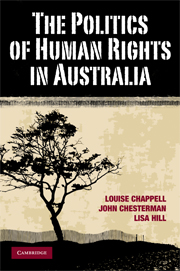Book contents
- Frontmatter
- Contents
- Acknowledgements
- List of abbreviations
- Introduction
- 1 Human Rights
- 2 Protecting Human Rights
- 3 A Bill of Rights?
- 4 Electoral Rights in Australia
- 5 The Rights of Indigenous Australians
- 6 Gender and Sexuality Rights
- 7 Refugees
- 8 Civil and Political Rights in an Age of Terror
- Notes
- Index
- References
6 - Gender and Sexuality Rights
- Frontmatter
- Contents
- Acknowledgements
- List of abbreviations
- Introduction
- 1 Human Rights
- 2 Protecting Human Rights
- 3 A Bill of Rights?
- 4 Electoral Rights in Australia
- 5 The Rights of Indigenous Australians
- 6 Gender and Sexuality Rights
- 7 Refugees
- 8 Civil and Political Rights in an Age of Terror
- Notes
- Index
- References
Summary
The presumption that men and women enjoy equal rights in Australia does not stand up to close scrutiny. Historically – and up to the present day – Australian women have suffered disadvantage and discrimination due to gender-based stereotypes, and as a result, they continue to be underrepresented in public office and within the senior ranks of the business community. Australian women persistently experience a higher incidence of domestic violence and sexual assault than do men, and are discriminated against in the workplace in terms of pay and conditions, including access to maternity leave. Particular groups of women, including those in Indigenous communities and lesbians, have not only been overrepresented in some of these areas of discrimination, but also experience unique forms of disadvantage due to the intersection of their gender, race and/or sexuality.
Although Australia is a signatory to the Convention on the Elimination of All Forms of Discrimination against Women (CEDAW), the key international women's rights convention, and has codified some of its articles in the Sex Discrimination Act, the seriousness with which Australia takes its obligations under the Convention has been questioned. Developments throughout the 1990s effectively dismantled crucial women's policy machinery. Moreover, the unwillingness of the former Howard government to strengthen Australian women's rights provisions by not signing on to the CEDAW Optional Protocol (see below) coupled with the limited resources given to addressing specific gender-based disadvantage represent a further erosion of the already fragile framework that exists to protect women's rights.
- Type
- Chapter
- Information
- The Politics of Human Rights in Australia , pp. 154 - 193Publisher: Cambridge University PressPrint publication year: 2009



